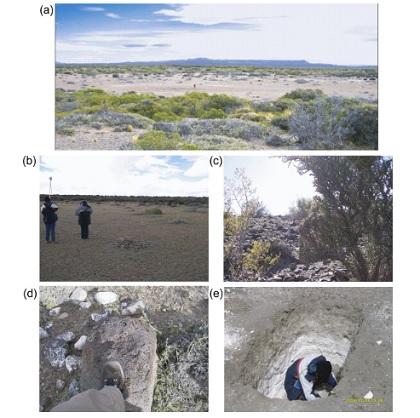Claudia B. Prezzi, María Julia Orgeira, Rogelio D. Acevedo, Juan Federico Ponce, Oscar Martinez, Jorge O. Rabassa, Hugo Corbella, Carlos Vásquez, Mauricio González-Guillot. Ignacio Subías
2 012
Physics of the Earth and Planetary Interiors Volumes 192–193, February 2012, Pages 21-34
An impact origin has been proposed for the circular structures found in Bajada del Diablo, Patagonia, Argentina. Taking into account its extension and the number of impact structures, Bajada del Diablo would be the largest meteoritic impact areas known on Earth, being an extremely interesting area for the research of impact events and processes. Moreover, the global distribution of known impact structures shows a surprising asymmetry. Particularly, South America has only seven described areas. It is evident that this situation is an artifact, highlighting the importance of intensifying the research in the least studied areas such as Argentina. Circular structures in Bajada del Diablo have been identified on two rock types: the Quiñelaf eruptive complex and Pampa Sastre Formation. In the first case, circular structures are placed in olivine basalts. On the other hand, Pampa Sastre Formation (late Pliocene/early Pleistocene) corresponds to conglomerate layers with basalt clasts boulder and block in size in a coarse sandy matrix. With the aim of further the investigation of the proposed impact origin for these circular structures, we carried out detailed topographic, magnetic and electromagnetic ground surveys in two circular structures (“8” and “A”) found in Pampa Sastre conglomerates. Both circular structures are simple, bowl-shaped with rim diameters of 300 m and maximum depths of 10 m. They have been partially filled in by debris flows from the rims and wind-blown sands. Two preliminary magnetic profiles have also been carried out in circular structure “G” found in Quiñelaf basalts. The magnetic anomalies show a circular pattern with a slightly negative and relatively flat signal in the circular structures’ bases. Furthermore in the circular structures’ rims, high-amplitude, conspicuous and localized (short wavelength) anomalies are observed. Such large amplitude and short wavelength anomalies are not detected outside the circular structures. For all used frequencies, the electromagnetic profiles show lower apparent electrical conductivities in the circular structures’ base, while the rims present notably higher values. Curvature attributes, analytic signal, horizontal gradient and Euler solutions were calculated for the magnetic data. 2.5D magnetic models were developed across the studied circular structures. Our results suggest that in the circular structures’ bases up to 12 m of Pampa Sastre conglomerate would have been removed. On the contrary, the circular structures’ rims exhibit high-amplitude, localized magnetic anomalies and higher apparent electrical conductivities, which would be related to the anomalous accumulation of basalt boulders and blocks remanently magnetized. Such high-amplitude anomalies are not present outside the surveyed circular structures. The geomorphological, geological and geophysical features of the studied circular structures can only be explained by means of an extra-terrestrial projectile impact. We conclude that, considering the results obtained to date, Bajada del Diablo should be envisaged as a focus of further research, which could provide novel information about impact events, associated processes and their evidences. Particularly, the data produced in this study could represent one of the first documented geophysical signatures of the impact of a comet nucleus on Earth.

